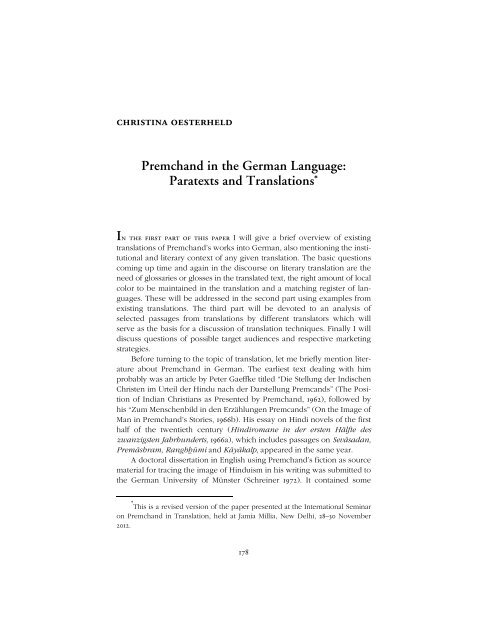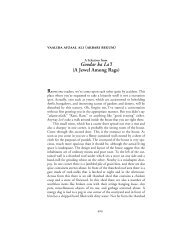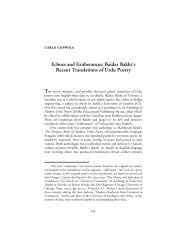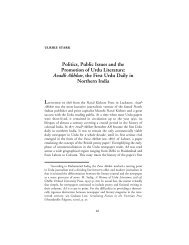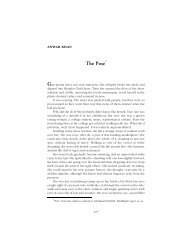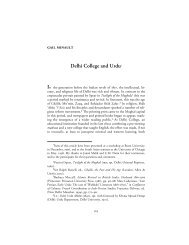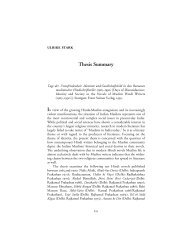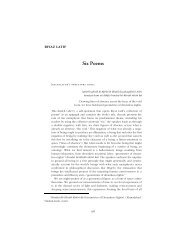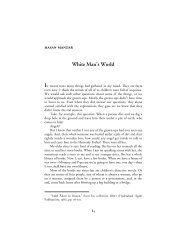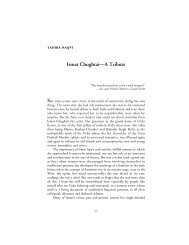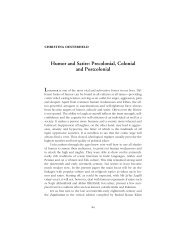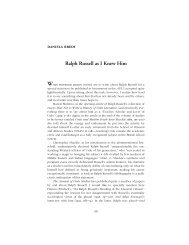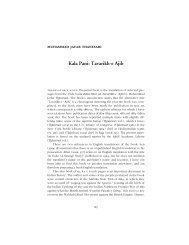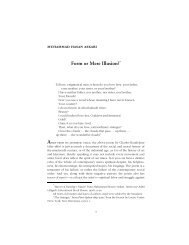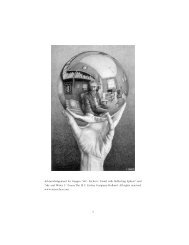Premchand in the German Language: Paratexts and Translations*
Premchand in the German Language: Paratexts and Translations*
Premchand in the German Language: Paratexts and Translations*
You also want an ePaper? Increase the reach of your titles
YUMPU automatically turns print PDFs into web optimized ePapers that Google loves.
christ<strong>in</strong>a oesterheld<br />
<strong>Premch<strong>and</strong></strong> <strong>in</strong> <strong>the</strong> <strong>German</strong> <strong>Language</strong>:<br />
<strong>Paratexts</strong> <strong>and</strong> Translations *<br />
In <strong>the</strong> first part of this paper I will give a brief overview of exist<strong>in</strong>g<br />
translations of <strong>Premch<strong>and</strong></strong>ís works <strong>in</strong>to <strong>German</strong>, also mention<strong>in</strong>g <strong>the</strong> <strong>in</strong>stitutional<br />
<strong>and</strong> literary context of any given translation. The basic questions<br />
com<strong>in</strong>g up time <strong>and</strong> aga<strong>in</strong> <strong>in</strong> <strong>the</strong> discourse on literary translation are <strong>the</strong><br />
need of glossaries or glosses <strong>in</strong> <strong>the</strong> translated text, <strong>the</strong> right amount of local<br />
color to be ma<strong>in</strong>ta<strong>in</strong>ed <strong>in</strong> <strong>the</strong> translation <strong>and</strong> a match<strong>in</strong>g register of languages.<br />
These will be addressed <strong>in</strong> <strong>the</strong> second part us<strong>in</strong>g examples from<br />
exist<strong>in</strong>g translations. The third part will be devoted to an analysis of<br />
selected passages from translations by different translators which will<br />
serve as <strong>the</strong> basis for a discussion of translation techniques. F<strong>in</strong>ally I will<br />
discuss questions of possible target audiences <strong>and</strong> respective market<strong>in</strong>g<br />
strategies.<br />
Before turn<strong>in</strong>g to <strong>the</strong> topic of translation, let me briefly mention literature<br />
about <strong>Premch<strong>and</strong></strong> <strong>in</strong> <strong>German</strong>. The earliest text deal<strong>in</strong>g with him<br />
probably was an article by Peter Gaeffke titled ìDie Stellung der Indischen<br />
Christen im Urteil der H<strong>in</strong>du nach der Darstellung Premc<strong>and</strong>sî (The Position<br />
of Indian Christians as Presented by <strong>Premch<strong>and</strong></strong>, 1962), followed by<br />
his ìZum Menschenbild <strong>in</strong> den Erzählungen Premc<strong>and</strong>sî (On <strong>the</strong> Image of<br />
Man <strong>in</strong> <strong>Premch<strong>and</strong></strong>ís Stories, 1966b). His essay on H<strong>in</strong>di novels of <strong>the</strong> first<br />
half of <strong>the</strong> twentieth century (H<strong>in</strong>diromane <strong>in</strong> der ersten Hälfte des<br />
zwanzigsten Jahrhunderts, 1966a), which <strong>in</strong>cludes passages on Sevāsadan,<br />
Premāshram, Rangbẖūmi <strong>and</strong> Kāyākalp, appeared <strong>in</strong> <strong>the</strong> same year.<br />
A doctoral dissertation <strong>in</strong> English us<strong>in</strong>g <strong>Premch<strong>and</strong></strong>ís fiction as source<br />
material for trac<strong>in</strong>g <strong>the</strong> image of H<strong>in</strong>duism <strong>in</strong> his writ<strong>in</strong>g was submitted to<br />
<strong>the</strong> <strong>German</strong> University of Münster (Schre<strong>in</strong>er 1972). It conta<strong>in</strong>ed some<br />
* This is a revised version of <strong>the</strong> paper presented at <strong>the</strong> International Sem<strong>in</strong>ar<br />
on <strong>Premch<strong>and</strong></strong> <strong>in</strong> Translation, held at Jamia Millia, New Delhi, 28–30 November<br />
2012.<br />
178
Christ<strong>in</strong>a Oesterheld • 179<br />
<strong>in</strong>terest<strong>in</strong>g po<strong>in</strong>ts on <strong>the</strong> relation between literature <strong>and</strong> religion, <strong>the</strong><br />
fictional <strong>and</strong> factual world, etc., but it probably did not at all contribute to<br />
<strong>the</strong> propagation of <strong>Premch<strong>and</strong></strong>ís works <strong>in</strong> <strong>German</strong>-speak<strong>in</strong>g countries.<br />
Gaeffke aga<strong>in</strong> devoted some pages to <strong>Premch<strong>and</strong></strong> <strong>in</strong> his H<strong>in</strong>di Literature<br />
<strong>in</strong> <strong>the</strong> Twentieth Century which was published <strong>in</strong> <strong>German</strong>y <strong>in</strong> 1978.<br />
Here he first mentioned <strong>Premch<strong>and</strong></strong> <strong>in</strong> <strong>the</strong> context of G<strong>and</strong>hiís <strong>in</strong>fluence<br />
on H<strong>in</strong>di literature, judg<strong>in</strong>g that his early short stories ìwere of no literary<br />
value, but brea<strong>the</strong>d <strong>the</strong> spirit of nationalismî (37), <strong>and</strong> <strong>the</strong>n dealt with <strong>the</strong><br />
novels Sevāsadan, Premāshram, Karmabẖūmi <strong>and</strong> Rangbẖūmi (38–41)<br />
<strong>and</strong> with Gōdān (52–53). All of <strong>the</strong> aforementioned works were addressed<br />
to an academic audience <strong>and</strong> apparently were read only by <strong>the</strong> small<br />
circle of scholars <strong>in</strong> <strong>the</strong> field.<br />
While not published <strong>in</strong> <strong>German</strong>, <strong>the</strong> work of <strong>the</strong> <strong>German</strong> scholar<br />
Siegfried A. Schulz on <strong>Premch<strong>and</strong></strong> is never<strong>the</strong>less of some <strong>in</strong>terest here<br />
because he discussed <strong>German</strong> translations. His first article on <strong>Premch<strong>and</strong></strong><br />
dealt with Gōdān (1972). This was followed by a talk organized by <strong>the</strong><br />
Indian Council for Cultural Relations <strong>in</strong> New Delhi <strong>in</strong> 1981 titled ì<strong>Premch<strong>and</strong></strong>:<br />
A Western Appraisal,î which also was clearly not meant for consumption<br />
<strong>in</strong> <strong>German</strong>y <strong>and</strong> was not translated <strong>in</strong>to <strong>German</strong>. In this talk he<br />
mentioned that <strong>Premch<strong>and</strong></strong> had received very little attention <strong>in</strong> <strong>the</strong> <strong>German</strong><br />
media. Only one <strong>German</strong> language newspaper, <strong>the</strong> Swiss Neue Zürcher<br />
Zeitung, had published an article on <strong>the</strong> occasion of <strong>Premch<strong>and</strong></strong>ís birth<br />
centenary (20–21). In <strong>the</strong> first part of his talk he concentrated on discuss<strong>in</strong>g<br />
Gōdān with special emphasis on <strong>the</strong> social <strong>and</strong> political concerns of <strong>the</strong><br />
novel <strong>and</strong> its historical as well as literary background. On <strong>the</strong> o<strong>the</strong>r h<strong>and</strong>,<br />
he was very well aware that only a close read<strong>in</strong>g of <strong>the</strong> text would result<br />
<strong>in</strong> ìvalid data <strong>in</strong> regard to literary criteriaî (25). He also clearly advocated a<br />
comparative approach <strong>and</strong> stressed <strong>the</strong> <strong>in</strong>fluence of Dickens, which he saw<br />
as very prom<strong>in</strong>ent <strong>in</strong> Gōdān. His more elaborate comparative study of<br />
Gōdān <strong>and</strong> Dickensí Hard Times (1972) had also been published <strong>in</strong> English<br />
only <strong>and</strong> had probably not been noticed even <strong>in</strong> <strong>German</strong> academia.<br />
The Urdu version of one of <strong>Premch<strong>and</strong></strong>ís stories (H<strong>in</strong>di: ìDō Bailōñ kī<br />
Katẖāî; Urdu: ìDō Bailî) was <strong>in</strong>cluded <strong>in</strong> <strong>the</strong> Chrestomathie der Urdu-<br />
Prosa des 19. und 20. Jahrhunderts (Reader of Urdu Prose from <strong>the</strong> N<strong>in</strong>eteenth<br />
<strong>and</strong> Twentieth Centuries, 1965 <strong>and</strong> 1977) with a short <strong>in</strong>troduction<br />
<strong>and</strong> a glossary, but no translation.<br />
<strong>German</strong> Translations of <strong>Premch<strong>and</strong></strong><br />
The follow<strong>in</strong>g account cannot claim to be exhaustive. It <strong>in</strong>cludes only
180 • The Annual of Urdu Studies, No. 28<br />
those works which I could trace while work<strong>in</strong>g on <strong>the</strong> subject. It is quite<br />
possible that fur<strong>the</strong>r translations of short stories appeared <strong>in</strong> literary<br />
journals but are not listed <strong>in</strong> library catalogs.<br />
As far as I could determ<strong>in</strong>e, <strong>Premch<strong>and</strong></strong> was translated <strong>in</strong>to <strong>German</strong><br />
for <strong>the</strong> first time <strong>in</strong> 1958, not from <strong>the</strong> orig<strong>in</strong>al H<strong>in</strong>di (or Urdu, for that<br />
matter) but from English. It was a collection of his short stories, published<br />
under <strong>the</strong> title E<strong>in</strong>e H<strong>and</strong>voll Weizen (A H<strong>and</strong>ful of Wheat) by <strong>the</strong> East<br />
<strong>German</strong> publisher Aufbau Verlag Berl<strong>in</strong>, based on an English collection of<br />
<strong>the</strong> same name published <strong>in</strong> 1955 by <strong>the</strong> Peopleís Publish<strong>in</strong>g House, New<br />
Delhi. The volume <strong>in</strong>cludes <strong>the</strong> follow<strong>in</strong>g stories:<br />
H<strong>in</strong>di Title English Title <strong>German</strong> Title<br />
ìSavā Sēr Gēhūñî A H<strong>and</strong>ful of Wheat E<strong>in</strong>e H<strong>and</strong>voll Weizen<br />
ìShatranj kē Kẖilāṛīî The Chess Players Die Schachspieler<br />
ìKajākīî Kazaki Kasaki<br />
ìḌikrī ke Rūpayeî The Decree Das Urteil<br />
ìBaṛē Gẖar kī BēÅīî<br />
Daughter of a Noble Die Tochter aus<br />
Family<br />
vornehmer Familie<br />
ìSamar Yātrāî The Battle March Der große Marsch<br />
ìĪdgāhî Idgah Das Idgach<br />
ìSujan Bẖagatî Sujan <strong>the</strong> Devout Sujan der Fromme<br />
ìNamak kā Darogāî The Salt Inspector Der Salz<strong>in</strong>spektor<br />
ìĪshvarīya Nyāyî Heavenly Justice Göttliche Gerechtigkeit<br />
ìPanč Parameshvarî The Village Judge Der Dorfrichter<br />
ìPūs kī Rātî A W<strong>in</strong>ter Night E<strong>in</strong>e W<strong>in</strong>ternacht<br />
ìKapẖan/Kafanî The Shroud Das Leichentuch<br />
ìÄẖākur kā Kuāñî The Thakurís Well<br />
Der Brunnen des<br />
Thakur<br />
It is obvious that <strong>the</strong> translations of <strong>the</strong> titles very closely follow <strong>the</strong><br />
English version. It needs to be mentioned, however, that one short story<br />
from <strong>the</strong> English collection (ìForgivenessî; H<strong>in</strong>di: ìKshamāî) was not<br />
<strong>in</strong>cluded <strong>in</strong> <strong>the</strong> <strong>German</strong> volume. Unless <strong>the</strong> story was added only to <strong>the</strong><br />
second edition of <strong>the</strong> English collection (1962), which I have before me,<br />
<strong>the</strong>re might have been some ideological reasons for not <strong>in</strong>clud<strong>in</strong>g it <strong>in</strong> <strong>the</strong><br />
<strong>German</strong> volume as <strong>the</strong> story presented a very negative image of Muslim<br />
rule <strong>in</strong> Spa<strong>in</strong> <strong>and</strong> could thus be understood to <strong>in</strong>stigate or fur<strong>the</strong>r prejudice<br />
aga<strong>in</strong>st a religious community.<br />
The translation of ìKafanî was republished <strong>in</strong> <strong>the</strong> anthology of Indian<br />
short stories Der Tigerkönig (The Tiger K<strong>in</strong>g) <strong>in</strong> 1966. Ano<strong>the</strong>r short story,<br />
ìDas K<strong>in</strong>dî (The Child; H<strong>in</strong>di: ìBālakî) was translated by W. A. Oerley<br />
from Madan Guptaís English version <strong>and</strong> published <strong>in</strong> <strong>the</strong> anthology Der<br />
sprechende Pflug (The Talk<strong>in</strong>g Plough) <strong>in</strong> 1962. In <strong>the</strong> same year, Der
Christ<strong>in</strong>a Oesterheld • 181<br />
Brunnen des Thakur (The Thakurís Well), ano<strong>the</strong>r anthology with stories<br />
by <strong>Premch<strong>and</strong></strong> <strong>and</strong> o<strong>the</strong>rs, was published at Leipzig. Unfortunately I have<br />
not been able to get hold of this book.<br />
These two collections were followedówith a considerable gapóby<br />
two translations directly from H<strong>in</strong>di, which are <strong>the</strong> only translations so far<br />
of novels by <strong>Premch<strong>and</strong></strong> <strong>in</strong>to <strong>German</strong>: Nirmala, translated by Margot<br />
Gatzlaff, published by Verlag Volk und Welt, Berl<strong>in</strong>, <strong>in</strong> 1976; <strong>and</strong> Gōdān,<br />
translated by Irene Zahra, published by Manesse Verlag, Zürich, <strong>in</strong> 1979.<br />
The only <strong>German</strong> translations from Urdu versions of <strong>Premch<strong>and</strong></strong><br />
stories that I have before me were published after a gap of several years<br />
<strong>in</strong> 1989 by Ursula Ro<strong>the</strong>n-Dubs <strong>in</strong> her reader Allahs <strong>in</strong>discher Garten: E<strong>in</strong><br />
Lesebuch der Urdu-Literatur (Allahís Indian Garden: A Reader of Urdu<br />
Literature). The stories are ìZwei Ochsenî (ìDō Bailî) <strong>and</strong> ìDie Schachspielerî<br />
(ìShatranj kī Bāzīî).<br />
A collection of stories translated from H<strong>in</strong>di by Konrad Meisig was<br />
also published <strong>in</strong> 1989 <strong>and</strong> had <strong>the</strong> ìChess Playersî as its title story. Here<br />
we have <strong>the</strong> only case of three different <strong>German</strong> versions of one story,<br />
albeit based on H<strong>in</strong>di/English <strong>in</strong> <strong>the</strong> first case, on Urdu <strong>in</strong> <strong>the</strong> second <strong>and</strong><br />
on H<strong>in</strong>di <strong>in</strong> <strong>the</strong> third. These three translations can thus offer a very good<br />
textual basis for a comparative study on <strong>the</strong> translation praxis. The contents<br />
of this second short story collection <strong>in</strong> <strong>German</strong> are as follows:<br />
H<strong>in</strong>di Title<br />
ìShatranj kē Kẖilāṛīî<br />
ìMōÅar kē ČẖīñÅēî<br />
ìÄẖākur kā Kuāñî<br />
ìPūs kī Rātî<br />
ìSavā sēr Gēhūñî<br />
ìNashāî<br />
ìYah Bẖī Nashā, Vah Bẖī Nashāî<br />
ìKafanî<br />
ìĀtmārāmî<br />
ìJādūî<br />
ìManovrittiî<br />
ìJulūsî<br />
ìMōÅērām Jī Shāstrīî<br />
ìDō Bailōñ kī Katẖāî<br />
<strong>German</strong> Title<br />
Die Schachspieler<br />
Autospritzer<br />
Thâkurs Brunnen<br />
E<strong>in</strong>e Nacht im Januar<br />
E<strong>in</strong>e<strong>in</strong>viertel Kilo Weizen<br />
Der Rausch<br />
Rausch Bleibt Rausch<br />
Das Leichentuch<br />
Goldschmied und Papagei<br />
Die Bezauberung<br />
Das Naturell e<strong>in</strong>er Hure<br />
Die Demonstration<br />
Moterâm Jî Shâstrî<br />
Die Geschichte von den beiden Ochsen<br />
As you will notice, five stories were already conta<strong>in</strong>ed <strong>in</strong> <strong>the</strong> first<br />
<strong>German</strong> collection <strong>and</strong> <strong>the</strong>se are among <strong>Premch<strong>and</strong></strong>ís masterpieces, which<br />
could not be excluded from any representative collection. Meisig was<br />
aware of <strong>the</strong> earlier <strong>German</strong> translations <strong>and</strong> also consulted a number of
182 • The Annual of Urdu Studies, No. 28<br />
English translations, but it is obvious from his render<strong>in</strong>gs of <strong>the</strong> texts that<br />
he tried to arrive at his own version.<br />
Last <strong>in</strong> <strong>the</strong> series of translations from <strong>Premch<strong>and</strong></strong> is ìAutospritzerî (A<br />
Car Splash<strong>in</strong>g; H<strong>in</strong>di: ìMōÅar kē ČẖīñÅēî), based on an English translation<br />
of 1969. This story was <strong>in</strong>cluded <strong>in</strong> <strong>the</strong> anthology of Indian short stories<br />
titled Zwischen den Welten (Between <strong>the</strong> Worlds), edited by Cornelia<br />
Zetzsche <strong>and</strong> published on <strong>the</strong> occasion of India be<strong>in</strong>g designated <strong>the</strong><br />
ma<strong>in</strong> guest at <strong>the</strong> Frankfurt Book Fair <strong>in</strong> 2006. Strangely enough, <strong>the</strong><br />
translation from <strong>the</strong> orig<strong>in</strong>al H<strong>in</strong>di prepared by Konrad Meisig was not<br />
used for this anthologyóI am not sure whe<strong>the</strong>r <strong>the</strong> editor of <strong>the</strong> publication<br />
was even aware of Meisigís translation. Here aga<strong>in</strong> a comparison of<br />
<strong>the</strong> two translations may yield <strong>in</strong>terest<strong>in</strong>g results.<br />
While look<strong>in</strong>g at <strong>the</strong> choice of texts <strong>and</strong> <strong>the</strong> paratext it is important to<br />
keep <strong>the</strong> circumstances of <strong>the</strong> publication <strong>in</strong> m<strong>in</strong>d. In this context I will<br />
briefly deal with only one publication: <strong>the</strong> short story collection E<strong>in</strong>e<br />
H<strong>and</strong>voll Weizen (A H<strong>and</strong>ful of Wheat) whose details were given above.<br />
It seems quite obvious that <strong>the</strong> choice of <strong>the</strong> English collection published<br />
by <strong>the</strong> Peopleís Publish<strong>in</strong>g House (PPH) was <strong>the</strong> first, or even only, choice<br />
for <strong>the</strong> East <strong>German</strong> (GDR) publisher because of <strong>the</strong> close ideological<br />
aff<strong>in</strong>ity of <strong>the</strong> Indian publisher with <strong>the</strong> Soviet bloc. It is possible that<br />
f<strong>in</strong>ancial concerns also played a big part <strong>in</strong> <strong>the</strong> decision. The GDR was<br />
always short of foreign exchange. Hence buy<strong>in</strong>g <strong>the</strong> rights from any o<strong>the</strong>r<br />
publisher might have proved too costly. But apart from such extra-literary<br />
considerations, <strong>the</strong> texts chosen for <strong>the</strong> PPH collection were representative<br />
enough, <strong>the</strong> quality of P. C. Guptaís translations was up to <strong>the</strong> mark, <strong>and</strong><br />
<strong>the</strong>re were not too many o<strong>the</strong>r English translations around at <strong>the</strong> time.<br />
The translation obviously fitted well <strong>in</strong>to <strong>the</strong> wider project of fur<strong>the</strong>r<strong>in</strong>g<br />
ties with nonaligned Third World countries <strong>and</strong> of publiciz<strong>in</strong>g literature of<br />
social criticism which was close to <strong>the</strong> mode of socialist realism prescribed<br />
for authors <strong>in</strong> <strong>the</strong> Soviet bloc <strong>in</strong> <strong>the</strong> late 1950s.<br />
Apart from <strong>the</strong>se ideological considerations common readers <strong>in</strong> <strong>the</strong><br />
socialist countries were eager to read about life <strong>in</strong> parts of <strong>the</strong> world to<br />
which <strong>the</strong>y usually had no access. In <strong>the</strong> GDR, <strong>the</strong> publish<strong>in</strong>g house Volk<br />
und Welt (The People <strong>and</strong> <strong>the</strong> World) <strong>in</strong> Berl<strong>in</strong> specialized <strong>in</strong> translations<br />
from foreign languages, but translated books were published by many<br />
o<strong>the</strong>r publish<strong>in</strong>g houses as well. Translated literature from all languages,<br />
European as well as non-European, sold very well. First editions were<br />
often sold out with<strong>in</strong> a couple of days. Books were usually subsidized<br />
<strong>and</strong> thus affordable for everybody. Publication <strong>and</strong> hence also translation<br />
choices were thus not necessarily based on commercial considerations. It<br />
needs to be stressed that until <strong>the</strong> reunification of <strong>German</strong>y a wide range
Christ<strong>in</strong>a Oesterheld • 183<br />
of Indian authors had been published <strong>in</strong> <strong>the</strong> GDR, among <strong>the</strong>m many<br />
who did not subscribe to any formula of social realism.<br />
<strong>Paratexts</strong><br />
In his comment on <strong>the</strong> <strong>German</strong> translation of Gōdān Schulz remarked: ìIt<br />
also lacks a solid <strong>in</strong>troductory essay which, as I will discuss a little later, is<br />
an absolute desideratumî (1981, 21). At <strong>the</strong> end of his talk he expla<strong>in</strong>ed <strong>in</strong><br />
detail what he expected an <strong>in</strong>troduction to achieve:<br />
The only th<strong>in</strong>g people like this speaker can do is to write better <strong>in</strong>troductions<br />
to <strong>Premch<strong>and</strong></strong>ís narratives <strong>and</strong> try to <strong>in</strong>terpret his work <strong>in</strong> a manner<br />
that would alert <strong>and</strong> enlighten <strong>the</strong> Western reader <strong>in</strong> regard to apparent<br />
<strong>in</strong>consistencies as perceived by him, <strong>in</strong>consistencies which have <strong>the</strong>ir<br />
orig<strong>in</strong> <strong>in</strong> <strong>the</strong> widely divergent traditions <strong>and</strong> cultures of India <strong>and</strong> <strong>the</strong> West.<br />
(ibid., 42)<br />
Apart from <strong>the</strong> problematic lump<strong>in</strong>g toge<strong>the</strong>r of ì<strong>the</strong> Westî as if this<br />
would by a homogenous entity, Schulz was wrong with regard to <strong>the</strong><br />
Gōdān translation which is followed by an essay (ìNachwort,î postscript),<br />
a brief note on <strong>the</strong> translation <strong>and</strong> a glossary. His advocacy of explicatory<br />
paratext as necessary explicatory material to translations from Indian languages<br />
was preach<strong>in</strong>g to <strong>the</strong> converted. None of <strong>the</strong> translations published<br />
previously to his talk or later went without postscripts or <strong>in</strong>troductions<br />
<strong>and</strong> glossaries. It is noteworthy, however, that many of <strong>the</strong>se essays follow<br />
<strong>the</strong> translated text <strong>in</strong>stead of preced<strong>in</strong>g it as an <strong>in</strong>troduction does. In a<br />
way <strong>the</strong>y are thus less obtrusive. The reader is <strong>in</strong>vited to first of all turn to<br />
<strong>the</strong> text, <strong>and</strong> may also read <strong>the</strong> postscript <strong>and</strong> consult <strong>the</strong> glossary only if<br />
he or she feels <strong>the</strong> need to do so. The two anthologies conta<strong>in</strong><strong>in</strong>g stories by<br />
different authors, however, have <strong>in</strong>troductions preced<strong>in</strong>g <strong>the</strong> translations.<br />
On a panel discuss<strong>in</strong>g H<strong>in</strong>di literature dur<strong>in</strong>g a conference <strong>in</strong> Lisbon<br />
<strong>in</strong> July 2012, a participant strongly condemned <strong>the</strong> practice of add<strong>in</strong>g<br />
explanatory notes, <strong>in</strong>troductions or glossaries to literary translations. He<br />
expressed <strong>the</strong> conviction that a literary text has to be trusted to st<strong>and</strong> on<br />
its own feet. This may very well hold true for texts from similar cultural<br />
backgrounds, but what about cultural translations between not so similar<br />
realms? When <strong>the</strong> reader of <strong>the</strong> translation is to be left alone with <strong>the</strong> text,<br />
any allusions to <strong>the</strong> source culture which are alien to <strong>the</strong> target culture<br />
will largely go unnoticed thus narrow<strong>in</strong>g or limit<strong>in</strong>g <strong>the</strong> realization of <strong>the</strong><br />
text. The reader will probably fill <strong>in</strong> <strong>the</strong> gaps <strong>in</strong> <strong>the</strong> text <strong>and</strong> visualize images<br />
evoked by <strong>the</strong> text accord<strong>in</strong>g to his/her own cultural background. To a
184 • The Annual of Urdu Studies, No. 28<br />
certa<strong>in</strong> degree this is unavoidable <strong>and</strong> also desirable, but if <strong>the</strong> source<br />
language/culture is completely obliterated, <strong>the</strong> reader will miss a chance<br />
to exp<strong>and</strong> his/her own knowledge of <strong>the</strong> world, of <strong>the</strong> human situation <strong>in</strong><br />
o<strong>the</strong>r parts of <strong>the</strong> world, will not delve <strong>in</strong>to <strong>the</strong> unfamiliar. The delicate<br />
balance between <strong>the</strong> familiar <strong>and</strong> unfamiliar that a literary translation may<br />
achieve will be tilted too much towards <strong>the</strong> familiar. Hence <strong>the</strong> decision<br />
for or aga<strong>in</strong>st a paratext should be made for any <strong>in</strong>dividual text <strong>in</strong> accordance<br />
with its cultural content. The translation of a short story about modern<br />
urban middle-class life may go very well without additional explanations,<br />
whereas Gōdān is a different matter altoge<strong>the</strong>r. Here, as <strong>in</strong> <strong>the</strong> field of<br />
literature <strong>in</strong> general, one should not resort to prescriptions of any k<strong>in</strong>d.<br />
And as Nirmaljeet Oberoi beautifully puts it, by provid<strong>in</strong>g a detailed piece<br />
of cultural <strong>in</strong>formation ìÖ what we lose <strong>in</strong> grace we may ga<strong>in</strong> <strong>in</strong> communicationî<br />
(2007, 56).<br />
André Lefevere advocated paratext exactly to overcome imperialist<br />
appropriation:<br />
When we no longer translate Ch<strong>in</strong>ese Tíang poetry ìas ifî it were Imagist<br />
blank verse, which it manifestly is not, we shall be able to beg<strong>in</strong> to underst<strong>and</strong><br />
Tíang poetry on its own terms. This means, however, that we shall<br />
have to tell <strong>the</strong> readers of our translations what Tíang poetry is really like,<br />
by means of <strong>in</strong>troductions, <strong>the</strong> detailed analysis of selected texts, <strong>and</strong> such.<br />
We shall, <strong>the</strong>refore, have to learn to skip <strong>the</strong> leap we often call ìof <strong>the</strong> imag<strong>in</strong>ationî<br />
but which could be much more aptly called ìof imperialism.î<br />
(1999, 78)<br />
He <strong>the</strong>n added that this blame could not be laid on Western cultures only<br />
ósimilar practices could be observed <strong>in</strong> Ch<strong>in</strong>ese translations as well (ibid.),<br />
<strong>and</strong> probably <strong>in</strong> all cultures of <strong>the</strong> world.<br />
In keep<strong>in</strong>g with this practice, none of <strong>the</strong> books we deal with here<br />
was considered to st<strong>and</strong> on its own without this additional material. The<br />
explanatory or <strong>in</strong>troductory texts usually <strong>in</strong>clude some <strong>in</strong>formation on <strong>the</strong><br />
literary tradition, <strong>the</strong> historical, cultural <strong>and</strong> social context of <strong>the</strong> texts,<br />
biographical notes on <strong>Premch<strong>and</strong></strong> <strong>and</strong> a more or less detailed evaluation<br />
of his work. Some also refer to <strong>the</strong> language situation with regard to H<strong>in</strong>di<br />
<strong>and</strong> Urdu.<br />
In Gōdān, <strong>the</strong> postscript (Nachwort) was written by Annemarie Etter,<br />
a scholar of English <strong>and</strong> Sanskrit with an <strong>in</strong>timate knowledge of India. The<br />
postscript of Nirmala was written by its translator, a renowned scholar of<br />
H<strong>in</strong>di, <strong>and</strong> that of <strong>the</strong> story collection E<strong>in</strong>e H<strong>and</strong>voll Weizen by Bianca<br />
Schorr, a scholar who specialized <strong>in</strong> modern Indian history. Schorrís outlook<br />
was more sociopolitical than literary <strong>and</strong> she laid more stress on <strong>the</strong><br />
political <strong>and</strong> ideological function of literature than on its aes<strong>the</strong>tic aspects.
Christ<strong>in</strong>a Oesterheld • 185<br />
Her general remarks on modern Indian literature as predom<strong>in</strong>antly didactic,<br />
which <strong>in</strong> her view <strong>the</strong> audience obviously dem<strong>and</strong>s <strong>and</strong> appreciates (1958,<br />
200), reveal a strong <strong>in</strong>fluence of <strong>the</strong> ìProgressiveî concept of literature <strong>and</strong><br />
also demonstrate that she was not aware of <strong>the</strong> diversity of <strong>the</strong> literary<br />
l<strong>and</strong>scape of India. Margot Gatzlaff, <strong>the</strong> translator of Nirmala, wrote a<br />
quite detailed ìafterwordî outl<strong>in</strong><strong>in</strong>g <strong>Premch<strong>and</strong></strong>ís life <strong>and</strong> works <strong>and</strong> <strong>the</strong>ir<br />
ideology but did not at all mention <strong>the</strong> process or method of translation.<br />
Different postscripts thus also reflect <strong>the</strong> context of publication. All<br />
books published <strong>in</strong> <strong>the</strong> GDR devote much space to <strong>Premch<strong>and</strong></strong>ís progressive<br />
lean<strong>in</strong>gs <strong>and</strong> to <strong>the</strong> social situation depicted <strong>in</strong> his works. They are<br />
thus <strong>in</strong> keep<strong>in</strong>g with <strong>the</strong> general political atmosphere, with <strong>the</strong> metanarrative<br />
of enlightenment, emancipation <strong>and</strong> social progress, <strong>and</strong> <strong>the</strong><br />
centrality of class struggles. Annemarie Etterís postscript to <strong>the</strong> Gōdān<br />
translation briefly outl<strong>in</strong>es <strong>the</strong> emergence of modern H<strong>in</strong>di <strong>and</strong> describes<br />
<strong>Premch<strong>and</strong></strong>ís life <strong>and</strong> literary career <strong>in</strong> more detail than <strong>the</strong> earlier texts.<br />
She <strong>the</strong>n goes on to provide <strong>the</strong> historical <strong>and</strong> political background to <strong>the</strong><br />
novel, sums up <strong>the</strong> ma<strong>in</strong> story l<strong>in</strong>e <strong>and</strong> presents a critical evaluation of <strong>the</strong><br />
novel. Interest<strong>in</strong>gly, her assessment of <strong>the</strong> social situation <strong>and</strong> <strong>the</strong> future<br />
outlook for Indiaís peasantry is more pessimistic (1979, 716) than <strong>the</strong> assessment<br />
of Bianca Schorr, who <strong>in</strong> 1958 expressed ra<strong>the</strong>r high hopes for<br />
social uplift <strong>and</strong> successful leftist politics <strong>in</strong> India (208).<br />
Konrad Meisigís postscript is <strong>the</strong> shortest. After a brief outl<strong>in</strong>e of<br />
<strong>Premch<strong>and</strong></strong>ís life <strong>and</strong> literary activities, <strong>and</strong> <strong>the</strong> topics <strong>and</strong> ideological<br />
content/background of his works, Meisig stresses <strong>the</strong> great <strong>and</strong> last<strong>in</strong>g<br />
<strong>in</strong>fluence <strong>Premch<strong>and</strong></strong> has had on H<strong>in</strong>di literatureóa fact <strong>the</strong> o<strong>the</strong>r writers<br />
did not pay much attention to. Problematic is Meisigís statement that Urdu<br />
was <strong>the</strong> language of Indian Muslims (1989, 136), <strong>and</strong> he also does not bo<strong>the</strong>r<br />
to mention that <strong>Premch<strong>and</strong></strong>ís <strong>in</strong>fluence on Urdu fiction was as prom<strong>in</strong>ent<br />
as it was on H<strong>in</strong>di fiction. It should perhaps be mentioned that Meisigís<br />
volume appeared from a publish<strong>in</strong>g house that specialized <strong>in</strong> scholarly<br />
publications.<br />
The most recent anthology of Indian short stories <strong>in</strong> <strong>German</strong> translation<br />
opens with an <strong>in</strong>troduction by Cornelia Zetzsche, who has not studied<br />
Indian languages <strong>and</strong> thus approaches Indian literatures through English.<br />
Her lack of cultural knowledge is revealed <strong>in</strong> statements such as <strong>the</strong> one <strong>in</strong><br />
which she calls ghazals <strong>and</strong> <strong>the</strong> Urdu language an ìErf<strong>in</strong>dung muslimischer<br />
Erobererî (<strong>in</strong>vention of Muslim conquerors, 2006, 17). She, never<strong>the</strong>less,<br />
strongly advocates translations from Indian languages <strong>and</strong> presents a very<br />
modern outlook which consciously avoids ìexoticiz<strong>in</strong>gî India <strong>and</strong> its literatures.<br />
Aga<strong>in</strong>st this background it cannot be understood why she did<br />
not use any of <strong>the</strong> available direct translations from Indian languages for
186 • The Annual of Urdu Studies, No. 28<br />
<strong>the</strong> anthology.<br />
Words common to most glossaries are names of food items, garments<br />
<strong>and</strong> plants, religious terms, terms of address, place names, Indian <strong>in</strong>stitutions<br />
such as pančāyat <strong>and</strong> more abstract terms such as dẖarma, etc., as<br />
well as objects of everyday use which have no counterparts <strong>in</strong> <strong>German</strong>y.<br />
The most <strong>in</strong>accurate glossary is <strong>the</strong> one accompany<strong>in</strong>g <strong>the</strong> anthology Der<br />
sprechende Pflug. Some of <strong>the</strong> glosses are wrong, some too unspecific to<br />
add to a better underst<strong>and</strong><strong>in</strong>g of <strong>the</strong> text, e.g., when ìdupaÅÅaî is expla<strong>in</strong>ed<br />
/translated as ìe<strong>in</strong> Kleidungsstückî (a piece of garment) (Oerley 1962, 425).<br />
In addition to a glossary, Nirmala also conta<strong>in</strong>s footnotes expla<strong>in</strong><strong>in</strong>g<br />
social customs such as dowry, purdah, etc. The glossary of Zwischen den<br />
Welten conta<strong>in</strong>s fewer mistakes <strong>and</strong> has more detailed explanations, but<br />
<strong>the</strong> few mistakes to be found here are very annoy<strong>in</strong>g, such as plac<strong>in</strong>g <strong>the</strong><br />
Ch<strong>and</strong>ni Chowk <strong>in</strong> New Delhi (Zetzsche 2006, 697) or translat<strong>in</strong>g ìPitajiî<br />
as ìrespected Pitaî (ibid., 708) without expla<strong>in</strong><strong>in</strong>g what pitā means!<br />
Despite <strong>the</strong>ir occasional flaws, glossaries never<strong>the</strong>less build bridges<br />
for underst<strong>and</strong><strong>in</strong>g some of <strong>the</strong> underly<strong>in</strong>g concepts, images, values, etc.<br />
of <strong>the</strong> words used <strong>in</strong> <strong>the</strong> texts. Without such aids <strong>the</strong> <strong>German</strong> reader<br />
would not be able to construct images <strong>in</strong> his m<strong>in</strong>d of <strong>the</strong> items he comes<br />
across <strong>in</strong> a story or to grasp at least some of <strong>the</strong> connotations of expressions<br />
taken from ano<strong>the</strong>r language.<br />
An <strong>in</strong>terest<strong>in</strong>g case of a different k<strong>in</strong>d of cultural translation is <strong>the</strong><br />
Urdu short stories of Munir D. Ahmad who lives <strong>in</strong> <strong>German</strong>y. Most of his<br />
stories deal with life <strong>in</strong> <strong>German</strong>y <strong>and</strong> are populated overwhelm<strong>in</strong>gly by<br />
<strong>German</strong> characters. Instead of add<strong>in</strong>g explanatory notes, <strong>the</strong> author chose<br />
to give explanations of <strong>German</strong> phenomena <strong>in</strong> <strong>the</strong> literary text itself,<br />
whereby <strong>the</strong> text as a whole turns <strong>in</strong>to a means of convey<strong>in</strong>g cultural<br />
<strong>in</strong>formation. These <strong>in</strong>terventions, however, sometimes prove to be a<br />
burden on <strong>the</strong> texture of <strong>the</strong> story thus reduc<strong>in</strong>g <strong>in</strong>terest <strong>in</strong> <strong>the</strong> characters<br />
<strong>and</strong> <strong>the</strong> action, <strong>the</strong>reby reduc<strong>in</strong>g <strong>the</strong> storyís readability. The practice of<br />
<strong>in</strong>clud<strong>in</strong>g explanatory notes <strong>in</strong> <strong>the</strong> literary text itself is usually not adopted<br />
<strong>in</strong> <strong>the</strong> translations under discussion here.<br />
The Translations<br />
The four important translators from H<strong>in</strong>di <strong>and</strong> Urdu have an academic<br />
background. They are well-versed <strong>in</strong> <strong>the</strong> respective Indian language(s)<br />
<strong>and</strong> possess <strong>the</strong> required cultural knowledge. In contrast to <strong>the</strong>m,<br />
Marianne Grycz-Liebgen who translated <strong>the</strong> short stories from English<br />
<strong>in</strong>to <strong>German</strong> was a professional translator of European languages without
Christ<strong>in</strong>a Oesterheld • 187<br />
any expertise <strong>in</strong> Indian culture.<br />
Translation, of course, is an endless process, as endless as <strong>the</strong> potential<br />
of a literary text. Any work can be translated all over aga<strong>in</strong> with ever<br />
new results. ìIntention <strong>and</strong> <strong>in</strong>terpretation lead to different texts <strong>in</strong> different<br />
situations. Each step means selection <strong>and</strong> a clos<strong>in</strong>g <strong>and</strong> (re)open<strong>in</strong>g of<br />
probabilities from both sides. But <strong>the</strong> sides never meetî (Vermeer 2006,<br />
52). Translation, as is <strong>the</strong> case with all communication, thus results <strong>in</strong> a<br />
ìreduction of complexityî (Luhmann qtd. <strong>in</strong> ibid., 64), <strong>and</strong> <strong>in</strong> translation<br />
we have a doubled case of communication, or, as Vermeer calls it, a twostep<br />
process (ibid., 67) with <strong>the</strong> translator as <strong>the</strong> site of <strong>the</strong> change between<br />
two (or even more, <strong>in</strong> <strong>the</strong> case of English as <strong>the</strong> medium) systems. The<br />
stimulation achieved by <strong>the</strong> result<strong>in</strong>g translation aga<strong>in</strong> conta<strong>in</strong>s its own<br />
complexities which are different from <strong>the</strong> complexities of <strong>the</strong> source.<br />
The translator is <strong>in</strong>fluenced <strong>in</strong> his choices by his or her own idiosyncrasies<br />
as well as by <strong>the</strong> more general cultural <strong>and</strong> literary environment he<br />
or she works <strong>in</strong>, by <strong>the</strong> (imag<strong>in</strong>ed) expectations of <strong>the</strong> target audience,<br />
<strong>the</strong> publisher, literary critics, colleagues, etc. Hence different translations<br />
of a given text may yield fasc<strong>in</strong>at<strong>in</strong>g results with regard to <strong>the</strong> choices<br />
made by <strong>the</strong> translator. Such a thorough, word-by-word analysis of <strong>the</strong><br />
complete texts, however, cannot be attempted <strong>in</strong> <strong>the</strong> present paper. Here<br />
<strong>the</strong> focus will be on a few selected cultural items or concepts <strong>and</strong> some<br />
obvious flaws <strong>in</strong> translation.<br />
Among <strong>the</strong> translators, it is <strong>in</strong>terest<strong>in</strong>g to note that only Irene Zahra<br />
commented upon her translation of Gōdān <strong>and</strong> expla<strong>in</strong>ed why she deemed<br />
it necessary to have a short glossary added to <strong>the</strong> text. Moreover, she admitted<br />
to hav<strong>in</strong>g ìcorrectedî <strong>the</strong> text where it seemed to conta<strong>in</strong> errors<br />
<strong>and</strong> <strong>in</strong>consistencies due to <strong>the</strong> ill health <strong>and</strong> early death of <strong>the</strong> author,<br />
who was not able to correct or copy edit <strong>the</strong> manuscript (1979, 718). This<br />
practice might look highly questionable, but probably enhanced <strong>the</strong><br />
readability of <strong>the</strong> result<strong>in</strong>g <strong>German</strong> text. Basil Hatim remarked with regard<br />
to translations from Arabic, which he demonstrated as a highly explicative<br />
language: ìÖ is <strong>the</strong>re any po<strong>in</strong>t <strong>in</strong> impress<strong>in</strong>g <strong>the</strong>se differences on, say,<br />
some Europeans whose languages do not usually opt for this degree of<br />
explicitness?î (1997, xv). A very good case <strong>in</strong> po<strong>in</strong>t would be <strong>the</strong> very<br />
elaborate, precise descriptions of action <strong>in</strong> H<strong>in</strong>di/Urdu with <strong>the</strong> help of<br />
conjunctive participles, compound verbs, participle constructions, etc.<br />
These usually have to be simplified <strong>in</strong> <strong>German</strong> because <strong>the</strong> <strong>German</strong> language<br />
simply does not possess <strong>the</strong> l<strong>in</strong>guistic arsenal for such a m<strong>in</strong>ute<br />
dissection of an action. In some cases, prefixes added to a verb or adverb<br />
may fulfill a similar function, but very often a complex construction <strong>in</strong><br />
H<strong>in</strong>di/Urdu will have to be replaced by a simple verb form <strong>in</strong> <strong>German</strong>.
188 • The Annual of Urdu Studies, No. 28<br />
In a brief note preced<strong>in</strong>g <strong>the</strong> text of <strong>the</strong> novel, Irene Zahra also<br />
expla<strong>in</strong>ed <strong>the</strong> cultural <strong>and</strong> religious mean<strong>in</strong>g of gōdān, which to my m<strong>in</strong>d<br />
provided a good open<strong>in</strong>g or po<strong>in</strong>t of departure for <strong>the</strong> read<strong>in</strong>g.<br />
Compar<strong>in</strong>g Three Translations of “The Chess Players”<br />
This comparison is, of course, complicated by <strong>the</strong> fact that <strong>the</strong> three translations<br />
are based on different source texts: The first on H<strong>in</strong>di via English,<br />
<strong>the</strong> second on a H<strong>in</strong>di version, <strong>and</strong> <strong>the</strong> third on an Urdu version. Never<strong>the</strong>less,<br />
different strategies can perhaps be del<strong>in</strong>eated. The ma<strong>in</strong> focus<br />
here will be on <strong>the</strong> readability of <strong>the</strong> translations, naturally with a view<br />
also to check <strong>the</strong>ir ìcorrectness,î by which I mean <strong>the</strong> correspondence<br />
with <strong>the</strong> atmosphere <strong>and</strong> overall sense of <strong>the</strong> orig<strong>in</strong>al. It is not my <strong>in</strong>tention<br />
here to po<strong>in</strong>t out m<strong>in</strong>or misunderst<strong>and</strong><strong>in</strong>gs <strong>and</strong> mistakes which may<br />
occur <strong>in</strong> any translation.<br />
Ursula Ro<strong>the</strong>n-Dubs was well aware of <strong>the</strong> <strong>in</strong>tricacies of translation.<br />
For her prose translations she chose a reader-oriented approach try<strong>in</strong>g to<br />
make <strong>the</strong> result<strong>in</strong>g text as enjoyable, colorful <strong>and</strong> often also witty as<br />
possible. Thus, her translation is much more vivid than that of Marianne<br />
Grysz-Liebgen, <strong>and</strong> almost never too literal. At <strong>the</strong> same time, however,<br />
her render<strong>in</strong>g of cultural items is closer to <strong>the</strong> orig<strong>in</strong>al as it is based on an<br />
actual knowledge of <strong>the</strong> realities of life <strong>in</strong> South Asia. Marianne Grycz-<br />
Liebgen, <strong>in</strong> contrast, tends to adapt cultural expressions to items known<br />
to a <strong>German</strong> reader. Thus, for example, <strong>in</strong> her version surma turns <strong>in</strong>to<br />
ìWimperntuscheî (mascara) <strong>and</strong> missī <strong>in</strong>to ìFarben für die Zähneî (color<br />
for <strong>the</strong> teeth) (see <strong>Premch<strong>and</strong></strong> 1958, 15). In both cases <strong>the</strong>se are faithful<br />
translations of <strong>the</strong> English version (<strong>Premch<strong>and</strong></strong> 1962, 9). Ro<strong>the</strong>n-Dubs<br />
gives more literal translations (ìAugenschwärzeî <strong>and</strong> ìGaumenfärbepulver,î<br />
respectively; 1989, 235). The latter two words are perhaps her own creations<br />
ó<strong>German</strong> does not have words for <strong>the</strong>se items. Meisig uses <strong>the</strong> same word<br />
for surma as Ro<strong>the</strong>n-Dubs, but describes missī as ìPulver zum Schwarzfärben<br />
der Zähneî (powder to blacken <strong>the</strong> teeth) (see <strong>Premch<strong>and</strong></strong> 1989, 1).<br />
The orig<strong>in</strong>al Urdu/H<strong>in</strong>di words or <strong>German</strong> equivalents do not appear <strong>in</strong><br />
<strong>the</strong>ir glossaries. This leads me to <strong>the</strong> question: Which translation works<br />
better for a <strong>German</strong> reader without knowledge of <strong>the</strong> Subcont<strong>in</strong>ent? Do <strong>the</strong><br />
unfamiliar words used by Ro<strong>the</strong>n-Dubs or Meisig succeed <strong>in</strong> evok<strong>in</strong>g an<br />
image of <strong>the</strong> item <strong>in</strong> question? Is it perhaps more appropriate to use<br />
words <strong>and</strong> create images of similar or related items which are known to<br />
<strong>the</strong> common reader? For a well-<strong>in</strong>formed reader, of course, Ro<strong>the</strong>n-Dubís<br />
accuracy is more enjoyable because he or she can make <strong>the</strong> l<strong>in</strong>k to <strong>the</strong>
Christ<strong>in</strong>a Oesterheld • 189<br />
object concerned with all its connotations <strong>and</strong> associations. The same is<br />
not possible for anyone without this cultural knowledge. Missī poses an<br />
additional problem. Beautiful teeth should be whiteóa concept that is<br />
common to many cultures. The function of missī as a beautifier would<br />
thus require fur<strong>the</strong>r explanation <strong>in</strong> addition to just nam<strong>in</strong>g or describ<strong>in</strong>g <strong>the</strong><br />
item. Such an explanation, however, is nowhere to be found with<strong>in</strong> <strong>the</strong><br />
story, nor is it <strong>in</strong> st<strong>and</strong>ard dictionaries.<br />
Marianne Grycz-Liebgenís translation as a whole captures <strong>the</strong> tone <strong>and</strong><br />
atmosphere of <strong>the</strong> story, but it occasionally deviates quite substantially from<br />
<strong>the</strong> orig<strong>in</strong>al. Many of <strong>the</strong>se deviations are based on mistakes <strong>in</strong> <strong>the</strong> English<br />
version. Thus, her translation of ìHaẓrat Ḥusa<strong>in</strong>î as ìProphet(en) Hussa<strong>in</strong>î<br />
(1958, 18) follows <strong>the</strong> English ìProphet Hussa<strong>in</strong>î (1962, 12). The word ìprophetî<br />
does not, of course, occur <strong>in</strong> <strong>the</strong> H<strong>in</strong>di <strong>and</strong> Urdu versions, which<br />
have Hazrat Husen (H<strong>in</strong>di: <strong>Premch<strong>and</strong></strong> 1996, vol. 13, 107) <strong>and</strong> <strong>the</strong> phrase<br />
shahīd-e Karbalā (Urdu: <strong>Premch<strong>and</strong></strong> 2003, 128) <strong>in</strong>stead. Aga<strong>in</strong> <strong>the</strong> word<br />
ìprophetî is used wrongly as a translation of ìvalīî <strong>in</strong> <strong>the</strong> English (1962,<br />
12) <strong>and</strong> <strong>German</strong> (1989, 19) versions. This is a serious mistake, given <strong>the</strong><br />
cultural <strong>and</strong> religious implications. A <strong>German</strong> translator with cultural<br />
knowledge of <strong>the</strong> Subcont<strong>in</strong>ent, <strong>and</strong> particularly of Muslim concepts,<br />
could have corrected <strong>the</strong> <strong>in</strong>accuracies of <strong>the</strong> English translation.<br />
Ano<strong>the</strong>r considerable shift <strong>in</strong> mean<strong>in</strong>g appears when <strong>the</strong> begum goes<br />
as far as <strong>the</strong> threshold of <strong>the</strong> sitt<strong>in</strong>g room but hesitates to enteróher deeply<br />
<strong>in</strong>gra<strong>in</strong>ed sense of modesty does not allow her to face a male stranger.<br />
This fact does not become really clear <strong>in</strong> <strong>the</strong> <strong>German</strong> translation, which<br />
says ìdurfte aber nicht weitergehenî (was, however, not allowed to proceed<br />
fur<strong>the</strong>r). The subtle nuance that she has <strong>in</strong>teriorized this <strong>in</strong>hibition is<br />
lost <strong>in</strong> Grycz-Liebgenís translation (1958, 12). Ro<strong>the</strong>n-Dubís translation (1989,<br />
239) clearly br<strong>in</strong>gs out this fact <strong>and</strong> hence is more appropriate.<br />
Meisig is <strong>the</strong> only translator who used diacritical marks for long vowels.<br />
He also provides some <strong>in</strong>formation on <strong>the</strong> pronunciation of Indian<br />
names, which seems necessary because he follows <strong>the</strong> English spell<strong>in</strong>g, but<br />
strangely enough he does not expla<strong>in</strong> his diacritical mark for vowel length.<br />
In all o<strong>the</strong>r translations <strong>the</strong>re are no diacritics. Indian names are written <strong>in</strong><br />
a ì<strong>German</strong>izedî form to facilitate pronunciation approximat<strong>in</strong>g <strong>the</strong> orig<strong>in</strong>al,<br />
such as ìDschunijaî <strong>in</strong>stead of ìJuniya.î This is <strong>in</strong> l<strong>in</strong>e with <strong>German</strong> publishersí<br />
guidel<strong>in</strong>es. Diacritics are generally understood to obstruct <strong>the</strong><br />
read<strong>in</strong>g of <strong>the</strong> text <strong>and</strong> to look too academic.
190 • The Annual of Urdu Studies, No. 28<br />
Compar<strong>in</strong>g Two Translations of “Motar ke Chh<strong>in</strong>te”<br />
Even a first glance reveals that <strong>in</strong> many <strong>in</strong>stances Meisigís translation is<br />
more colloquial <strong>and</strong> better catches <strong>the</strong> ironic tone of <strong>the</strong> orig<strong>in</strong>al. On <strong>the</strong><br />
o<strong>the</strong>r h<strong>and</strong>, some formulations read better <strong>in</strong> <strong>the</strong> <strong>in</strong>direct translation, but<br />
<strong>the</strong>re are a few factual mistakes <strong>in</strong> <strong>the</strong> translation from English, such as<br />
ìFeldwegî (dirt track; Zetzsche 2006, 121) <strong>in</strong>stead of ìGasseî (lane) for <strong>the</strong><br />
H<strong>in</strong>di galī (see <strong>Premch<strong>and</strong></strong> 1996, vol. 15, 470). A more serious flaw is <strong>the</strong><br />
omission of <strong>the</strong> ìSahibísî identity <strong>in</strong> <strong>the</strong> translation from English. The<br />
H<strong>in</strong>di text does not leave any doubt about <strong>the</strong> fact that <strong>the</strong> gentleman <strong>in</strong><br />
<strong>the</strong> car is a colonial officer. The ironic phrase ìsāhib bahādurî already<br />
suggests as much, <strong>and</strong> his a-grammatical H<strong>in</strong>di provides <strong>the</strong> f<strong>in</strong>al clue.<br />
Hence Meisig clearly identifies him as a colonial officer <strong>in</strong> his translation<br />
(see <strong>Premch<strong>and</strong></strong> 1989, 17). His wife is marked as British by <strong>the</strong> denom<strong>in</strong>ation<br />
ìmēm sahib,î which both translators reta<strong>in</strong>, but <strong>the</strong> explanation of<br />
ìMemsahibî as ìAnredeî (form of address) <strong>in</strong> <strong>the</strong> glossary to Zwischen<br />
den Welten (Zetzsche 2006, 705) does not clarify anyth<strong>in</strong>g for <strong>the</strong> un<strong>in</strong>formed<br />
reader.<br />
A problem faced by both translators <strong>and</strong> solved by nei<strong>the</strong>r of <strong>the</strong>m is<br />
<strong>the</strong> very ìEnglishî H<strong>in</strong>di spoken by <strong>the</strong> officer. In <strong>the</strong> translations he speaks<br />
correct st<strong>and</strong>ard <strong>German</strong>. Would it have been more to <strong>the</strong> po<strong>in</strong>t to have<br />
him speak broken <strong>German</strong>? I am not sureóit really is a difficult decision.<br />
The Translations of Nirmala <strong>and</strong> Godan<br />
Of <strong>the</strong> three translators we are concerned with here, Margot Gatzlaffís<br />
approach appears <strong>the</strong> most text-oriented, which occasionally hurts <strong>the</strong><br />
aes<strong>the</strong>tic quality of <strong>the</strong> end result. Thus, for <strong>in</strong>stance, she translated some<br />
idiomatic expressions too literally. A case <strong>in</strong> po<strong>in</strong>t is ìdūr sē salām<br />
karnāî (see <strong>Premch<strong>and</strong></strong> 1976, 12) which <strong>in</strong> its literal translation sounds<br />
odd <strong>and</strong> does not make much sense for a <strong>German</strong> reader. A better translation<br />
would have been ìÖ kann mir gestohlen bleiben.î At o<strong>the</strong>r places,<br />
however, she has tried her best to translate <strong>the</strong> text <strong>in</strong>to idiomatic <strong>German</strong>.<br />
Schulz referred to Zahraís translation of Gōdān <strong>in</strong> his talk <strong>and</strong> also<br />
mentioned his own which however, I was not able to trace. He claims to<br />
have lived <strong>in</strong> close contact with <strong>the</strong> novel for about three years, but<br />
perhaps it was never published. Here is his comment on <strong>the</strong> published<br />
translation: ìLast year, <strong>the</strong> Manesse Verlag <strong>in</strong> Zürich published a <strong>German</strong><br />
Gōdān translation by Irene Zahra which, when compared to my own,<br />
shows a few divergencies <strong>and</strong> ëvenialí errorsî (1981, 21). In a later passage
Christ<strong>in</strong>a Oesterheld • 191<br />
he takes up <strong>the</strong> problem of translat<strong>in</strong>g dharma/dharam which accord<strong>in</strong>g<br />
to him appears about one hundred times <strong>in</strong> Gōdān: ìA Western reader<br />
will want to know <strong>the</strong> exact mean<strong>in</strong>g <strong>and</strong> def<strong>in</strong>ition of <strong>the</strong> term, so that he<br />
can safely deal with it whenever it occursî (ibid., 36). Schulz had probably<br />
overlooked <strong>the</strong> short explanation of <strong>the</strong> term Dharma <strong>in</strong> <strong>the</strong> glossary (see<br />
<strong>Premch<strong>and</strong></strong> 1979, 719 entry 19) <strong>and</strong> <strong>the</strong> more detailed <strong>in</strong>formation on <strong>the</strong><br />
Dharma system with<strong>in</strong> <strong>the</strong> postscript (ibid., 713–14). To my m<strong>in</strong>d this<br />
explication provides a good basis for an underst<strong>and</strong><strong>in</strong>g of <strong>the</strong> use of <strong>the</strong><br />
word <strong>in</strong> <strong>Premch<strong>and</strong></strong>ís novel. The translator preferred to reta<strong>in</strong> <strong>the</strong> orig<strong>in</strong>al<br />
word throughout <strong>the</strong> text <strong>in</strong>stead of us<strong>in</strong>g a translation which would at<br />
best restrict <strong>and</strong> at worst misrepresent <strong>the</strong> concept.<br />
The Translation of “Balak”<br />
This story is an example of a lot of <strong>in</strong>formation <strong>and</strong> nuance be<strong>in</strong>g lost<br />
along <strong>the</strong> way. Some reduction of <strong>the</strong> orig<strong>in</strong>al text occurred already <strong>in</strong> <strong>the</strong><br />
English translation, <strong>and</strong> some more <strong>in</strong>accuracies <strong>and</strong> omissions were<br />
added dur<strong>in</strong>g <strong>the</strong> translation from English <strong>in</strong>to <strong>German</strong>. Thus, <strong>the</strong> <strong>German</strong><br />
text reads very matter-of-factly, laconic even, while <strong>in</strong> <strong>the</strong> orig<strong>in</strong>al we f<strong>in</strong>d<br />
many asides, many statements are clearly marked as <strong>the</strong> first-personnarratorís<br />
op<strong>in</strong>ion, assumption or impression, all of which is left out <strong>in</strong> <strong>the</strong><br />
translation. Thus, when <strong>the</strong> changed expression on Gangūís face is meticulously<br />
described by <strong>the</strong> narrator <strong>in</strong> <strong>the</strong> first scene <strong>in</strong> which <strong>the</strong> reader<br />
encounters him (<strong>Premch<strong>and</strong></strong> 1996, vol. 15, 181), this detailed impression is<br />
completely omitted. The translated text is thus watered down <strong>and</strong> becomes<br />
more one-dimensional than <strong>the</strong> orig<strong>in</strong>al. There also are some changes <strong>in</strong><br />
<strong>the</strong> sequence of <strong>the</strong> sentences <strong>in</strong> <strong>the</strong> English version, by which <strong>the</strong> translator<br />
probably wanted to improve on <strong>the</strong> story, but <strong>the</strong>se changes are not<br />
for <strong>the</strong> better. The narratorís emotional reactions are cut short, <strong>and</strong> <strong>the</strong><br />
f<strong>in</strong>al paragraph is bereft of some of its most poignant sentences <strong>in</strong> which<br />
<strong>the</strong> narrator accuses himself of mean-heartedness. The blame for most of<br />
<strong>the</strong>se blunders has to be put on <strong>the</strong> English translation, but more damage<br />
was also added by <strong>the</strong> <strong>German</strong> translator.<br />
Reception of <strong>the</strong> Translations<br />
The second edition of Gōdān which was published by Manesse <strong>in</strong> 2006<br />
got a good response <strong>in</strong> important pr<strong>in</strong>t media such as Die Zeit <strong>and</strong> Neue<br />
Zürcher Zeitung <strong>and</strong> was commended by some outst<strong>and</strong><strong>in</strong>g <strong>German</strong>
192 • The Annual of Urdu Studies, No. 28<br />
writers <strong>and</strong> critics. Here are some of <strong>the</strong> voices:<br />
Günter Grass, ìThis novel is a wonderful book.î<br />
Doro<strong>the</strong>a Dieckmann (Die Zeit), ìRead<strong>in</strong>g Gōdān means div<strong>in</strong>g <strong>in</strong>to <strong>the</strong><br />
legendary <strong>and</strong> still exist<strong>in</strong>g contrast between poor <strong>and</strong> rich, <strong>the</strong> countryside<br />
<strong>and</strong> <strong>the</strong> city, need <strong>and</strong> double st<strong>and</strong>ards, tradition <strong>and</strong> cynicism, a repressive<br />
family system <strong>and</strong> liberty brought forth by luxury. P<strong>in</strong>-sharp portraits<br />
of low caste peasants, Brahm<strong>in</strong> village elders, opportunist <strong>in</strong>tellectuals <strong>and</strong><br />
corrupt l<strong>and</strong>lords are embedded <strong>in</strong> an elaborate ensemble of exemplary<br />
episodes.î<br />
Mart<strong>in</strong> Zähr<strong>in</strong>ger (Neue Zürcher Zeitung), ì<strong>Premch<strong>and</strong></strong> develops a fasc<strong>in</strong>at<strong>in</strong>g<br />
precision <strong>in</strong> <strong>the</strong> description of social structures, religious patterns,<br />
economic procedures <strong>and</strong> most of all of <strong>the</strong> complicated, but closely knit<br />
fabric of feudal dependency. [Ö] In his political analysis <strong>Premch<strong>and</strong></strong> is at<br />
par with contemporaries such as Maxim Gorki or Mart<strong>in</strong> Anderson Nexö.<br />
[Ö] He is still worth read<strong>in</strong>g.î<br />
Matthias Koeffler (Buchmarkt), ìThe Indian classic about <strong>the</strong> hardships<br />
of peasant life thwarts every multicultural happ<strong>in</strong>ess.î 1<br />
It is, however, hard to assess how far this critical acclaim was reflected <strong>in</strong><br />
book sales. Amazon.de reported only one copy left <strong>in</strong> its stock on 27<br />
September 2012, but <strong>the</strong>n we do not know how many copies <strong>the</strong>y had<br />
ordered <strong>in</strong> <strong>the</strong> first place. It also needs to be mentioned that <strong>the</strong> first edition<br />
was f<strong>in</strong>ancially supported by a Swiss foundationóo<strong>the</strong>rwise <strong>the</strong> publication<br />
would probably not have been commercially viable. S<strong>in</strong>ce <strong>the</strong> translation<br />
already existed, costs were naturally much lower for <strong>the</strong> recent<br />
second edition. <strong>German</strong> translations from H<strong>in</strong>di <strong>and</strong> Urdu are widely used<br />
<strong>in</strong> university courses on <strong>the</strong> respective literary traditions, but <strong>in</strong>itially <strong>the</strong>y<br />
were of course not <strong>in</strong>tended for so limited a readership. Obviously <strong>the</strong><br />
<strong>in</strong>tended target audience was <strong>the</strong> wider read<strong>in</strong>g public. That only a small<br />
section of this audience could be reached is due to <strong>the</strong> k<strong>in</strong>d of publish<strong>in</strong>g<br />
houses <strong>in</strong>volved <strong>in</strong> most of <strong>the</strong>se endeavors. Barr<strong>in</strong>g perhaps <strong>the</strong> Swiss<br />
publish<strong>in</strong>g house Manesse Verlag, none of <strong>the</strong>m belongs to <strong>the</strong> <strong>in</strong>ner circle<br />
of powerful <strong>and</strong> rich publishers, hence <strong>the</strong>y were not able to <strong>in</strong>vest heavily<br />
<strong>in</strong> <strong>the</strong> market<strong>in</strong>g of <strong>the</strong>ir books <strong>and</strong> <strong>the</strong>y did not (<strong>and</strong> do not) have access<br />
to <strong>the</strong> big book sell<strong>in</strong>g cha<strong>in</strong>s on <strong>the</strong> high streets of cities or <strong>in</strong> big shopp<strong>in</strong>g<br />
malls. No reader will stumble upon any of <strong>the</strong>se books on display <strong>in</strong><br />
a shop w<strong>in</strong>dow or on a barga<strong>in</strong> counter. As a result one has to know about<br />
1 My translation. For <strong>the</strong> orig<strong>in</strong>als <strong>in</strong> <strong>German</strong>, see (http://www.amazon.de/Go<br />
dan-oder-Das-Opfer-roman/dp/371752108X/ref=sr_1_1?ie=UTF8&qid=1348737295&sr<br />
=8-1; retrieved 27 Sept. 2012).
Christ<strong>in</strong>a Oesterheld • 193<br />
<strong>the</strong>se books to try <strong>and</strong> locate <strong>the</strong>m.<br />
Conclusion<br />
As is to be expected, translation is always conditioned by <strong>the</strong> respective<br />
context. The examples have clearly demonstrated how formulations <strong>in</strong> <strong>the</strong><br />
target language, <strong>and</strong> even more obviously <strong>the</strong> paratexts, were <strong>in</strong>fluenced<br />
by <strong>the</strong> time at which <strong>the</strong> text was translated, <strong>the</strong> format or mode of publication,<br />
<strong>and</strong> <strong>the</strong> sociopolitical circumstances.<br />
The fact that none of <strong>the</strong> translations discussed <strong>in</strong> this paper st<strong>and</strong> on<br />
<strong>the</strong>ir own, all are supported by paratexts, po<strong>in</strong>ts to <strong>the</strong> need that was felt<br />
for cultural translation beyond <strong>the</strong> literary text itself.<br />
The choice of texts for translation is quite representative. <strong>Premch<strong>and</strong></strong>ís<br />
most famous short stories <strong>and</strong> Gōdān, <strong>the</strong> novel widely understood to be<br />
his best, are available <strong>in</strong> <strong>German</strong> translation, albeit perhaps mostly unnoticed<br />
by <strong>the</strong> general read<strong>in</strong>g public.<br />
The above analysis <strong>in</strong>dicates that an <strong>in</strong>timate knowledge of <strong>the</strong> Subcont<strong>in</strong>ent<br />
is vital for arriv<strong>in</strong>g at appropriate translations. Translations<br />
through English need not necessarily be <strong>in</strong>ferior to those from <strong>the</strong> orig<strong>in</strong>al<br />
languages if <strong>the</strong> English translations <strong>the</strong>y are based on do not deviate too<br />
much from <strong>the</strong> text <strong>and</strong> if <strong>the</strong> <strong>German</strong> translations are edited or proofread<br />
by a person with <strong>the</strong> cultural competence required for an accurate <strong>and</strong> at<br />
<strong>the</strong> same time <strong>in</strong>telligible representation of <strong>the</strong> orig<strong>in</strong>al. Without such a<br />
counter-check <strong>the</strong> result may conta<strong>in</strong> a number of serious misrepresentations.<br />
On <strong>the</strong> o<strong>the</strong>r h<strong>and</strong>, judg<strong>in</strong>g from my own experience, it is essential<br />
to have <strong>the</strong> draft read by a person without a knowledge of <strong>the</strong> Subcont<strong>in</strong>ent<br />
when a translation is produced by a South Asianist because only such an<br />
ìun<strong>in</strong>formedî person will be able to po<strong>in</strong>t out where <strong>the</strong> text is un<strong>in</strong>telligible<br />
for a general reader <strong>and</strong> where <strong>the</strong> language of <strong>the</strong> translation is too<br />
close to <strong>the</strong> orig<strong>in</strong>al, mak<strong>in</strong>g it sound awkward or clumsy <strong>in</strong> <strong>German</strong>.<br />
Ideally, thus, a translation project should always <strong>in</strong>volve at least two<br />
persons, one specialized <strong>in</strong> <strong>the</strong> source language <strong>and</strong> culture <strong>and</strong> <strong>the</strong> o<strong>the</strong>r<br />
one a mo<strong>the</strong>r-tongue speaker of <strong>the</strong> target language without knowledge<br />
of <strong>the</strong> source language.<br />
There also is an astonish<strong>in</strong>g imbalance <strong>in</strong> <strong>the</strong> ratio between translations<br />
from H<strong>in</strong>di <strong>and</strong> those from Urdu. The strik<strong>in</strong>gly small number of translations<br />
from Urdu can perhaps only be expla<strong>in</strong>ed by <strong>the</strong> predom<strong>in</strong>ance of<br />
scholars deal<strong>in</strong>g with H<strong>in</strong>di as compared to those work<strong>in</strong>g on Urdu. It is<br />
also possible that H<strong>in</strong>di texts were more easily availableó<strong>and</strong> <strong>in</strong> better<br />
editions.
194 • The Annual of Urdu Studies, No. 28<br />
Ano<strong>the</strong>r noteworthy fact is <strong>the</strong> still limited number of translations from<br />
<strong>Premch<strong>and</strong></strong>ís volum<strong>in</strong>ous oeuvre, given his high status <strong>in</strong> <strong>the</strong> canon of<br />
H<strong>in</strong>di <strong>and</strong> Urdu prose writ<strong>in</strong>g, compared to <strong>the</strong> number of translations of<br />
later H<strong>in</strong>di writers (Nirmal Varma, Yashpal, Mohan Rakesh, Uday Prakash,<br />
to name only <strong>the</strong> most prom<strong>in</strong>ent ones). Do his works not appeal to <strong>the</strong><br />
modern publisher/critic/reader? Have <strong>the</strong>y lost <strong>the</strong>ir cultural <strong>and</strong> social<br />
mean<strong>in</strong>g? The recent republication of <strong>the</strong> Gōdān translation <strong>and</strong> its critical<br />
acclaim would suggest o<strong>the</strong>rwise, but generally ma<strong>in</strong>stream publishers<br />
are more <strong>in</strong>terested <strong>in</strong> contemporary writ<strong>in</strong>g of a less overtly social-realist<br />
<strong>and</strong> occasionally idealist nature. The small <strong>in</strong>dependent publish<strong>in</strong>g house<br />
Draupadi <strong>in</strong> Heidelberg, which specializes <strong>in</strong> translations from Indian<br />
languages, does favor critical literature, but also has its ma<strong>in</strong> focus on<br />
contemporary writ<strong>in</strong>g. Hence we perhaps cannot expect much to be done<br />
<strong>in</strong> <strong>the</strong> near future as far as translat<strong>in</strong>g <strong>Premch<strong>and</strong></strong> <strong>in</strong>to <strong>German</strong> is concerned.<br />
As far as <strong>the</strong> exist<strong>in</strong>g translations are concerned, only Gōdān is still available<br />
<strong>in</strong> <strong>the</strong> recent edition. The older publications o<strong>the</strong>r than Gōdān have<br />
been out of pr<strong>in</strong>t for a long time, <strong>and</strong> <strong>the</strong>re is no chance of <strong>the</strong>m gett<strong>in</strong>g<br />
republished. Nirmala, Der Tigerkönig <strong>and</strong> E<strong>in</strong>e H<strong>and</strong>voll Weizen can be<br />
found <strong>in</strong> <strong>in</strong>ternet portals offer<strong>in</strong>g secondh<strong>and</strong> books, but Die Schachspieler<br />
seems to be unavailable even <strong>the</strong>re.<br />
Unfortunately, <strong>in</strong> <strong>German</strong>y <strong>the</strong> choice with ma<strong>in</strong>stream publishers<br />
often is to have a translation from <strong>the</strong> English version or none at all. Publishers<br />
tend to rely on <strong>the</strong> selection of authors who have been successful <strong>in</strong><br />
<strong>the</strong> English-language market <strong>in</strong>stead of mak<strong>in</strong>g <strong>the</strong>ir own risky <strong>and</strong> more<br />
costly choices. Thus, suggestions for translations from Indian languages<br />
usually orig<strong>in</strong>ate with specialists of <strong>the</strong>se languages <strong>in</strong> academia, not with<br />
publishers. As far as I can see, aggressive market<strong>in</strong>g is essential for <strong>the</strong><br />
success of any book <strong>in</strong> <strong>the</strong> marketplace. Dur<strong>in</strong>g <strong>the</strong> last two decades much<br />
hype was created when market<strong>in</strong>g English-language novels by Indian or<br />
Non-Resident Indian (NRI) authors, but similar efforts have never been seen<br />
for any Indian novel translated from a language o<strong>the</strong>r than English. q<br />
Works Cited<br />
Der Brunnen des Thakur: Indische Erzählungen (The Thakurís Well: Indian Stories).<br />
1962. Edited by Shanti Shastri <strong>and</strong> translated by Marianne Grycz-<br />
Liebgen, et al. Leipzig: Reclams Universal-Biblio<strong>the</strong>k.<br />
Etter, Annemarie. 1979. Nachwort (Postscript) to Godan Oder Die Opfergabe: Roman.<br />
Aus dem H<strong>in</strong>di übersetzt von Irene Zahra. Nachwort von Annemarie<br />
Etter. Zürich: Manesse Verlag. 705–16.
Christ<strong>in</strong>a Oesterheld • 195<br />
Gaeffke, Peter. 1978. H<strong>in</strong>di Literature <strong>in</strong> <strong>the</strong> Twentieth Century. (A History of<br />
Indian Literature, Vol. 8, Fasc. 5). Wiesbaden: Harrassowitz.<br />
óó. 1966a. H<strong>in</strong>diromane <strong>in</strong> der ersten Hälfte des zwanzigsten Jahrhunderts.<br />
Leiden: Brill.<br />
óó. 1966b. ìZum Menschenbild <strong>in</strong> den Erzählungen Premc<strong>and</strong>sî (On <strong>the</strong> Image<br />
of Man <strong>in</strong> <strong>Premch<strong>and</strong></strong>ís Stories). In Wiener Zeitschrift für die Kunde Südund<br />
Ostasiens und Archiv für Indische Philosophie, B<strong>and</strong> X. 6–65.<br />
óó. 1962. ìDie Stellung der <strong>in</strong>dischen Christen im Urteil der H<strong>in</strong>du nach der<br />
Darstellung Premc<strong>and</strong>sî (The Position of Indian Christians as Presented by<br />
<strong>Premch<strong>and</strong></strong>). In Wiener Zeitschrift für die Kunde Süd- und Ostasiens und<br />
Archiv für Indische Philosophie, B<strong>and</strong> VI. 15–28.<br />
Chrestomathie der Urdu-Prosa des 19. und 20. Jahrhunderts (Reader of Urdu Prose<br />
from <strong>the</strong> N<strong>in</strong>eteenth <strong>and</strong> Twentieth Centuries). 1977. Edited by M.A. Ansari<br />
<strong>and</strong> D. Ansari. Second edition, rev. & enlarged. Leipzig: Verlag Enzyklopädie.<br />
Chrestomathie der Urdu-Prosa des 19. und 20. Jahrhunderts (Reader of Urdu Prose<br />
from <strong>the</strong> N<strong>in</strong>eteenth <strong>and</strong> Twentieth Centuries). 1965. Edited by M.A. Ansari<br />
<strong>and</strong> D. Ansari. Leipzig: Verlag Enzyklopädie.<br />
Hatim, Basil. 1997. Communication Across Cultures: Translation Theory <strong>and</strong> Contrastive<br />
Text L<strong>in</strong>guistics. Exeter: University of Exeter Press.<br />
Lefevere, André. 1999. ìCompos<strong>in</strong>g <strong>the</strong> O<strong>the</strong>r.î In Post-colonial Translation: Theory<br />
<strong>and</strong> Practice. Edited by Susan Bassnett <strong>and</strong> Harish Trivedi. London; New<br />
York: Routledge. 75–94.<br />
Meisig, Konrad. 1989. Nachwort (Postscript) to Die Schachspieler: Erzählungen.<br />
Aus dem H<strong>in</strong>di übersetzt von Konrad Meisig <strong>in</strong> Zusammenarbeit mit Petra<br />
Christophersen. Wiesbaden: Sammlung Harrassowitz. 135–38.<br />
Oberoi, Nirmaljeet. 2007. ìTranslat<strong>in</strong>g Culture: Theory <strong>and</strong> Practice.î In Translation<br />
/Representation. Edited by Anisur Rahman <strong>and</strong> Ameena Kazi Ansari. New<br />
Delhi: Creative Books. 50–56.<br />
Oerley, W.A. 1962. Der Sprechende Pflug. Indien <strong>in</strong> Erzählungen se<strong>in</strong>er besten<br />
zeitgenössischen Autoren (The Talk<strong>in</strong>g Plow. India <strong>in</strong> Stories by Its Best<br />
Contemporary Authors). Auswahl und Redaktion W.A. Orley. Herrenalb;<br />
Schwarzwald: Horst Erdmann Verlag.<br />
<strong>Premch<strong>and</strong></strong>. 2007. The Great Stories of Munshi <strong>Premch<strong>and</strong></strong>: A Collection of Best<br />
Writ<strong>in</strong>gs by <strong>the</strong> Writer of <strong>the</strong> Masses. Worded by Virena Varma. Delhi:<br />
Manoj Publications.<br />
óó. 2003. Premč<strong>and</strong> kī Bīs Kahāniyān. Tartīb, <strong>in</strong>tikhāb-o-tanqīd: ḌākÅar Anvār<br />
Aḥmad. Lahore: Beacon Books.<br />
óó. 1998. Widows, Wives, <strong>and</strong> O<strong>the</strong>r Hero<strong>in</strong>es: Twelve Stories. Translated by David<br />
Rub<strong>in</strong>. Delhi: Oxford University Press.<br />
óó. [Premč<strong>and</strong>]. 1996. Premč<strong>and</strong> Račnāvalī. Edited by Ram An<strong>and</strong>. Kẖanḍ 14, 15.<br />
Dillī: Janvānī Prakhāshan.<br />
óó. [Premc<strong>and</strong>]. 1989. Die Schachspieler: Erzählungen. (The Chess Players: Stories).<br />
Aus dem H<strong>in</strong>di übersetzt von Konrad Meisig <strong>in</strong> Zusammenarbeit mit<br />
Petra Christophersen. Wiesbaden: Sammlung Harrassowitz.
196 • The Annual of Urdu Studies, No. 28<br />
óó. 1979. Godan Oder die Opfergabe: Roman. Aus dem H<strong>in</strong>di übersetzt von Irene<br />
Zahra. Nachwort von Annemarie Etter. Zürich: Manesse Verlag.<br />
óó. 1976. Nirmala oder die Geschichte e<strong>in</strong>es bitteren Lebens. Aus dem H<strong>in</strong>di.<br />
übersetzung, nachwort und anmerkungen von Margot Gatzlaff. Leipzig:<br />
Verlag Philipp Reclam jun.<br />
óó. [Prem Ch<strong>and</strong>]. 1962. A H<strong>and</strong>ful of Wheat <strong>and</strong> O<strong>the</strong>r Stories. Second ed. Selected<br />
<strong>and</strong> translated by P.C. Gupta. New Delhi: Peopleís Publish<strong>in</strong>g House.<br />
óó. 1960. The Secret of Culture <strong>and</strong> O<strong>the</strong>r Stories. Trans. by Madan Gupta. Bombay:<br />
Jaico Publ. House.<br />
óó. [Premtsch<strong>and</strong>]. 1958. E<strong>in</strong>e H<strong>and</strong>voll Weizen: Erzählungen (A H<strong>and</strong>ful of<br />
Wheat: Stories). Aus dem Englischen übersetzt nach der autorisierten Auswahl<br />
und Übertragung aus dem H<strong>in</strong>di von Marianne Grycz-Liebgen. Berl<strong>in</strong>:<br />
Aufbau-Verlag.<br />
Ro<strong>the</strong>n-Dubs, Ursula. 1989. Allahs Indischer Garten: E<strong>in</strong> Lesebuch der Urdu-Literatur.<br />
(Allahís Indian Garden: A Reader of Urdu Literature). Frauenfeld: Verlag<br />
im Waldgut.<br />
Schorr, Bianca. 1958. Nachwort (Postscript) to E<strong>in</strong>e H<strong>and</strong>voll Weizen: Erzählungen.<br />
Aus dem Englischen übersetzt nach der autorisierten Auswahl und Übertragung<br />
aus dem H<strong>in</strong>di von Marianne Grycz-Liebgen. Berl<strong>in</strong>: Aufbau-Verlag.<br />
199–209.<br />
Schre<strong>in</strong>er, Peter. 1972. The Reflection of H<strong>in</strong>duism <strong>in</strong> <strong>the</strong> Works of Premc<strong>and</strong>.<br />
Ph.D. diss., University of Münster.<br />
Schulz, Siefried A. 1981. ì<strong>Premch<strong>and</strong></strong>: A Western Appraisal.î New Delhi: Indian<br />
Council for Cultural Relations.<br />
óó. 1972. ì<strong>Premch<strong>and</strong></strong>ís Novel Godan: Echoes of Charles Dickens <strong>in</strong> an Indian<br />
Sett<strong>in</strong>g.î In Studies <strong>in</strong> Honor of Tatiana Fotitch. Edited by Josep M. Sola-<br />
Solé, Aless<strong>and</strong>ro S. Crisafulli, <strong>and</strong> Siegfried A. Schulz. Wash<strong>in</strong>gton D.C.:<br />
Catholic University Press. 341–66.<br />
Der Tigerkönig (The Tiger K<strong>in</strong>g). 1966. Edited by Helga Anton, et al. Berl<strong>in</strong>: Verlag<br />
Volk und Welt.<br />
Vermeer, Hans J. 2006. Luhmannís ìSocial Systemsî Theory: Prelim<strong>in</strong>ary Fragments<br />
for a Theory of Translation. Berl<strong>in</strong>: Frank & Timme.<br />
Zahra, Irene, trans. 1979. Zur Übersetzung (About <strong>the</strong> Translation) note to Godan<br />
Oder Die Opfergabe: Roman. Aus dem H<strong>in</strong>di übersetzt von Irene Zahra.<br />
Nachwort von Annemarie Etter. Zürich: Manesse Verlag. 717–18.<br />
Zetzsche, Cornelia, ed. 2006. Zwischen den Welten: Geschichten aus dem modernen<br />
Indien. (Between <strong>the</strong> Worlds: Stories from Modern India). Frankfurt; Leipzig:<br />
Insel Verlag.


